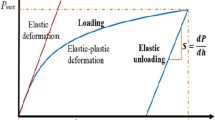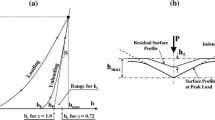Abstract
Whenever a nanoindent is placed near an edge, such as the free edge of the specimen or heterophase interface intersecting the surface, the elastic discontinuity associated with the edge produces artifacts in the load–depth data. Unless properly handled in the data analysis, the artifacts can produce spurious results that obscure any real trends in properties as functions of position. Previously, we showed that the artifacts can be understood in terms of a structural compliance, Cs, which is independent of the size of the indent. In the present work, the utility of the SYS (Stone, Yoder, Sproul) correlation is demonstrated in its ability to remove the artifacts caused by Cs. We investigate properties: (i) near the surface of an extruded polymethyl methacrylate rod tested in cross section, (ii) of compound corner middle lamellae of loblolly pine (Pinus taeda) surrounded by relatively stiff wood cell walls, (iii) of wood cell walls embedded in a polypropylene matrix with some poorly bonded wood–matrix interfaces, (iv) of AlB2 particles embedded in an aluminum matrix, and (v) of silicon-on-insulator thin film on substrate near the free edge of the specimen.
Similar content being viewed by others
References
W.C. Oliver and G.M. Pharr: Improved technique for determining hardness and elastic modulus using load and displacement sensing indentation experiments. J. Mater. Res. 7(6), 1564 (1992).
I.N. Sneddon: Relation between load and penetration in axisym-metric Boussinesq problem for punch of arbitrary profile. Int. J. Eng. Sci. 3, 47 (1965).
A. Bolshakov and G.M. Pharr: Inaccuracies in Sneddon’s solution for elastic indentation by a rigid cone and their implications for nanoindentation data analysis, in Thin Films: Stresses and Mechanical Properties VI, edited by W.W. Gerberich, H. Gao, J.E. Sundgren, and S.P. Baker (Mater. Res. Soc. Symp. Proc. 436, Pittsburgh, PA, 1997), p. 189.
M. Troyon and S. Lafaye: About the importance of introducing a correction factor in the Sneddon relationship for nanoindentation measurements. Philos. Mag. 86(33–35), 5299 (2006).
J.E. Jakes, C.R. Frihart, J.F. Beecher, R.J. Moon, and D.S. Stone: Experimental method to account for structural compliance in nanoindentation measurements. J. Mater. Res. 23(4), 1113 (2008).
R.B. King: Elastic analysis of some punch problems for a layered medium. Int. J. Solids Struct. 23(12), 1657 (1987).
M.F. Doerner and W.D. Nix: A method for interpreting the data from depth-sensing indentation instruments. J. Mater. Res. 1(4), 601 (1986).
D.S. Stone: Elastic rebound between an indenter and a layered specimen. I. Model. J. Mater. Res. 13(11), 3207 (1998).
K.B. Yoder, D.S. Stone, R.A. Hoffman, and J.C. Lin: Elastic rebound between an indenter and a layered specimen. II. Using contact stiffness to help ensure reliability of nanoindentation measurements. J. Mater. Res. 13(11), 3214 (1998).
A.C. Fischer-Cripps: Critical review of analysis and interpretation of nanoindentation test data. Surf. Coat. Technol. 200(14–15), 4153 (2006).
W.C. Oliver and G.M. Pharr: Measurement of hardness and elastic modulus by instrumented indentation: Advances in understanding and refinements to methodology. J. Mater. Res. 19(1), 3 (2004).
Y-T. Cheng and C-M. Cheng: Scaling, dimensional analysis, and indentation measurements. Mater. Sci. Eng., R 44(4–5), 91 (2004).
A.A. Elmustafa, S. Kose, and D.S. Stone: The strain-rate sensitivity of the hardness in indentation creep. J. Mater. Res. 22(4), 926 (2007).
D.S. Stone, K.B. Yoder, and W.D. Sproul: Hardness and elastic modulus of TiN based on continuous indentation technique and new correlation. J. Vac. Sci. Technol. A 9(4), 2543 (1991).
D.L. Joslin and W.C. Oliver: New method for analyzing data from continuous depth-sensing microindentation tests. J. Mater. Res. 5(1), 123 (1990).
M. Sakai and Y. Nakano: Elastoplastic load-depth hysteresis in pyramidal indentation. J. Mater. Res. 17(8), 2161 (2002).
N.A. Stilwell and D. Tabor: Elastic recovery of conical indentations. Proc. Phys. Soc. 78, 169 (1961).
N.B. Duque, Z.H. Melgarejo, and O.M. Suarez: Functionally graded aluminum matrix composites produced by centrifugal casting. Mater. Charact. 55(2), 167 (2005).
Z.H. Melgarejo, O.M. Suarez, and K. Sridharan: Wear resistance of a functionally-graded aluminum matrix composite. Scr. Mater., 55(1 Spec), 95 (2006).
Z.H. Melgarejo, O.M. Suarez, and K. Sridharan: Microstructure and properties of functionally graded Al–Mg–B composites fabricated by centrifugal casting. Compos. Part A: Appl. Sci. Manuf. 39(7), 1150 (2008).
N. Miller, K. Tapily, H. Baumgart, G.K. Cellar, F. Brunier, and A.A. Elmustafa: Nanomechanical properties of strained silicon-on-insulator (SOI) films epitaxially grown on Si1–xGex and layer transferred wafer bonding, in Surface and Interfacial Nano-mechanics, edited by R.F. Cook, W. Ducker, I. Szlufarska, and R.F. Antrim (Mater. Res. Soc. Symp. Proc. 1021E, Warrendale, PA, 2007), 1021–HH05.
R. Wimmer, B.N. Lucas, T.Y. Tsui, and W.C. Oliver: Longitudinal hardness and Young’s modulus of spruce tracheid secondary walls using nanoindentation technique. Wood Sci. Technol. 31(2), 131 (1997).
C.E. Gerber: Contact Problems for the Elastic Quarter-Plane and for the Quarter Space (Stanford University, Palo Alto, CA, 1968), p. 100.
S.S. Chiang, D.B. Marshall, and A.G. Evans: The response of solids to elastic/plastic indentation. I. Stresses and residual stresses. J. Appl. Phys. 53(1), 298 (1982).
K.L. Johnson: Contact Mechanics (Cambridge University Press, Cambridge, UK, 1985), p. 452.
C. Deppisch, G. Liu, J.K. Shang, and J. Economy: Processing and mechanical properties of AlB2 flake reinforced Al-alloy composites. Mater. Sci. Eng., A A225(1–2), 153 (1997).
K. Liu, X.L. Zhou, X-R. Chen, and W-J. Zhu: Structural and elastic properties of AlB2 compound via first-principles calculations. Physica B (Amsterdam) 388(1–2), 213 (2007).
J.J. Vlassak and W.D. Nix: Measuring the elastic properties of anisotropic materials by means of indentation experiments. J. Mech. Phys. Solids 42(8), 1223 (1994).
M. Hetenyi: Method of solution for elastic quarter-plane. ASME Trans. J. Appl. Mech. Ser. E, J. Appl. Mech. 27(2), 289 (1960).
M. Hetenyi: A general solution for the elastic quarter space. Trans. ASME Ser. E., J. Appl. Mech. 37(1), 70 (1970).
L.M. Keer, J.C. Lee, and T. Mura: Hetenyi’s elastic quarter space problem revisited. Int. J. Solids Struct. 19(6), 497 (1983).
L.M. Keer, J.C. Lee, and T. Mura: A contact problem for the elastic quarter space. Int. J. Solids Struct. 20(5), 513 (1984).
G.Y. Popov: An exact solution of the mixed elasticity problem in a quarter-space. Mech. Solids 38(6), 23 (2003).
N. Schwarzer, I. Hermann, T. Chudoba, and F. Richter: Contact modelling in the vicinity of an edge. Surf. Coat. Techol. 146–147, 371 (2001).
Author information
Authors and Affiliations
Corresponding author
Rights and permissions
About this article
Cite this article
Jakes, J.E., Frihart, C.R., Beecher, J.F. et al. Nanoindentation near the edge. Journal of Materials Research 24, 1016–1031 (2009). https://doi.org/10.1557/jmr.2009.0076
Received:
Accepted:
Published:
Issue Date:
DOI: https://doi.org/10.1557/jmr.2009.0076




